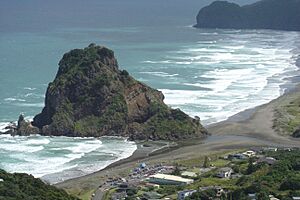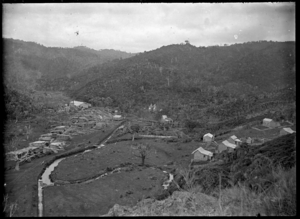Piha facts for kids
Quick facts for kids
Piha
|
|
|---|---|

Piha and Lion Rock from the access road above
|
|
| Country | New Zealand |
| Region | Auckland |
| Ward | Waitākere ward |
| Local board | Waitākere Ranges Local Board |
| Electorates |
|
| Area | |
| • Total | 5.24 km2 (2.02 sq mi) |
| Population
(June 2023)
|
|
| • Total | 1,070 |
| • Density | 204.2/km2 (528.9/sq mi) |
Piha is a beautiful coastal town in West Auckland. It's located on the western coast of the Auckland Region in New Zealand. Piha is one of the most popular beaches in the area. It's a favourite spot for people from Auckland to visit for a day trip, especially during summer.
Piha is about 39 kilometres west of Auckland city centre. It sits on the Tasman Sea coast, just north of the Manukau Harbour. It's also on the western edge of the Waitākere Ranges. North of Piha is Whites Beach, and to the south is Te Unuhanga-a-Rangitoto / Mercer Bay. You can only reach these beaches by walking. Other nearby beaches you can drive to include Karekare to the south and Anawhata to the north.
Contents
History of Piha
The Piha area has a rich history. It traditionally belongs to the Tāmaki Māori tribe called Te Kawerau ā Maki. The name Piha comes from Te Piha, which was the original name for Lion Rock. This name describes how waves crash against the rock.
This area was once home to many Māori villages and pā (fortified settlements). One pā was on a headland north of the beach called Te Waha Point. You can still see many karaka trees there, which are linked to the old pā. Lion Rock itself was the site of Whakaari pā. Experts have found old platforms, shell middens (piles of shells), and terraces on Lion Rock. They also found pieces of traditional Māori weaving. These findings show people lived here long before Europeans arrived.
Te Unuhanga-a-Rangitoto / Mercer Bay to the south has a traditional Māori name, Te Unuhanga o Rangitoto. This name comes from a story of the Te Kawerau ā Maki people. It tells how an ancestor named Tiriwa moved Rangitoto Island from the west coast to the Hauraki Gulf / Tīkapa Moana. The English name, Mercer Bay, is after Andrew Mercer. He was an Auckland settler who received land there in 1866.
In the early 1900s, people would travel by coach from Glen Eden to Piha for holidays. They would stay in guest houses.
Piha's Population and People
Piha covers an area of about 5.24 square kilometres. It has an estimated population of 1,070 people as of June 2023, . This means there are about 204 people living in each square kilometre.
The population of Piha has grown over the years. In 2018, there were 984 people living here. This was an increase from 858 people in 2013 and 822 people in 2006. There were 396 homes in Piha in 2018. The average age of people in Piha was 43.4 years.
Most people in Piha are of European descent (94.8%). Some also identify as Māori (13.4%), Pacific peoples (3.4%), or Asian (3.0%). About 19.2% of people in Piha were born outside New Zealand.
When it comes to religion, most people (66.8%) said they had no religion. About 18.9% were Christian. A small number followed Māori religious beliefs, Hindu, or Buddhist faiths.
Many people in Piha have a good education. About 35.1% of adults have a bachelor's degree or higher. The average income in Piha was $42,700. Many people (54.0%) work full-time.
Amazing Features and Geology of Piha
Piha has two main surf beaches, a calm lagoon, and several streams. The coastline and the Waitākere Ranges are great for walks. These walks, also called tramps, can be easy or very challenging. However, some parts of the Waitākere Ranges have been closed since 2018. This is to help stop the spread of an incurable disease called kauri dieback, which harms kauri trees.
Piha is famous for its black sand beach. This black colour comes from a lot of iron in the sand. This iron came from Mount Taranaki and older volcanoes in the area.
Lion Rock: Piha's Icon
Lion Rock is a natural landmark that separates North and South Piha beaches. It's an old volcanic neck that was formed 16 million years ago. It looks like a male lion lying down when you see it from the shore. Lion Rock is the first thing many visitors notice as they drive down to Piha. It has become a symbol not just for Piha, but for all of Auckland's West Coast. Lion Rock has even appeared on stamps and an Auckland phone book. In 1919, a memorial for local sawmill workers who fought in World War One was placed on Lion Rock.
Kitekite Falls and Other Waterways
About 2 kilometres inland from Piha, you'll find the beautiful Kitekite Falls on the Glen Esk stream. While not huge, they are very pretty. You can swim in a pool just above the falls all year round, but it's quite cold outside of summer! At the bottom of the falls, there's a sheltered picnic area. This spot is popular with families in the summertime. There's another pool between the top and bottom falls, but it's currently closed due to kauri dieback concerns.
About 2 kilometres inland, along the Piha Stream, there is also a small canyon. About 1 kilometre south of South Beach is 'The Gap'. At low tide, The Gap reveals another lagoon and a blowhole.
Surfing in Piha
Piha is a very important place for surfing in New Zealand. It's where board riding first started in the country in 1958. Piha has hosted many national and international surfing competitions.
Surf Lifesaving and Beach Safety
Two surf lifesaving clubs help keep people safe at Piha during summer. The Piha Surf Life Saving Club patrols the beach south of Lion Rock. This club was featured in the TV show Piha Rescue. The United North Piha Lifeguard Service looks after the beach north of Lion Rock. Both clubs mark safe swimming areas with red and yellow flags. It's always best to swim between these flags during patrol hours.
The ocean currents at Piha can be very strong and change quickly. These currents, called rip currents, can be dangerous. Lifeguards advise that the water can look calm, but strong rips might be hidden. If you are not a confident swimmer, it's safest to stay out of the water. Always listen to the lifeguards and swim between the red and yellow flags.
Piha Rescue TV Show
Piha Beach was the setting for a popular New Zealand reality television show called Piha Rescue. This show ran for 12 seasons over 14 years on TV1. It showed the daily lives of the surf life savers at Piha Beach. The show also taught people about beach safety, how to spot rip currents, and why it's important to swim between the flags.
Images for kids










